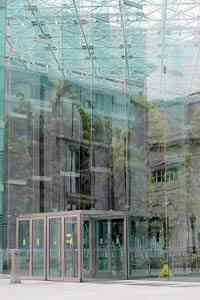Harsh Reflections
by Leslie Trew Magraw
Thwack. The woodthrush lies motionless, a downy patch on the city sidewalk. Suddenly, a wing flutters, an eye springs open and, after a few dazed circles, the bird flies off to resume its long journey north for the summer. Unfortunately, most birds that collide with windows aren’t as lucky.
In North America alone it is estimated that between 100 and 900 million birds collide with buildings each year, making this a leading cause of death for thousands of bird species. Most song birds migrate at night using stars to navigate, and skyscrapers with their twinkling individual office windows easily disorient and distract, leading birds away from the open sky and into harm’s way.
“Buildings that leave their lights burning throughout the night are wasting electricity and money, contributing to climate change and killing birds,” says Jim Monsma, cofounder of Washington, D.C.-based City Wildlife, a nonprofit wildlife rehabilitation group. “Turning the lights out should be a no-brainer.”
To make migrations less deadly, “Lights Out” bird-collision prevention programs have been popping up in major cities all over North America, like Boston, Chicago, New York City and Toronto, advocating that taller buildings turn off unnecessary lights at night during spring and fall migrations. “The birds that are largely impacted by the night time collisions are the neotropical migrants many of which are already declining,” says Caroline Kennedy, Defenders’ senior director of field conservation.
In Washington, D.C., last spring, City Wildlife volunteers—ranging from a local student to a single mother to a Georgetown University professor—gave up hours of precious sleep to walk the streets before first light every Monday and Friday from April through May to find out just how much of a problem buildings posed for migrating birds in the nation’s capital. “You’ve got to rise early to beat the crows,” says Monsma. “Otherwise they will get to the dead and injured birds first.”
In the end, volunteers found just 27 birds—far fewer than the norm for a major East Coast city, likely because Washington doesn’t have skyscrapers (an 1899 Act of Congress requires buildings stand lower than the U.S. Capitol). Of the birds found, some were stunned and with time—or the help of a wildlife rehabilitator—they flew away to greet another day. Other birds died on the spot or had to be euthanized, like an ovenbird blinded in one eye. Two buildings proved particularly deadly—one was an almost totally glass structure with several trees inside its well-lit lobby. The other was the newly constructed Washington Convention Center, which has a walkway consisting of two walls of glass and very little between to alert birds they are on the wrong path.
Ironically, the relatively new push for “green-building” practices has actually intensified bird mortality. Green-building certification programs promote the use of glass to increase natural light, which has the unintended consequence of making these otherwise “green” buildings a greater threat to birds flying during the day, when collisions are no less deadly. Anne Lewis, City Wildlife’s other co-founder and an architect by training, is working with the Green Building Council to make its Leadership in Energy and Environmental Design (LEED) certification more sensitive to birds. “Builders can now get LEED credits for introducing bird-friendly designs, so this is a huge step forward,” says Monsma.
As volunteer Lisbeth Strimple Fuisz puts it: “The future of bird life is urban.” That makes it especially important we ensure our cities are working for rather than against birds. Thanks to groups like City Wildlife, Lights Out participants and the engineers, wildlife biologists, city planners, volunteers and policymakers who are working together to prevent needless bird deaths, things may be looking up for our feathered friends.
Only select articles from Defenders are available online. To receive 4 issues annually of the full award-winning magazine, become a member of Defenders of Wildlife!

